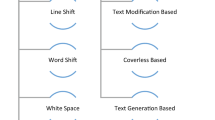Abstract
The recent development of deep learning has made a significant breakthrough in linguistic generative steganography. The text has become one of the most intensely used communication carriers on the Internet, making steganography an efficient carrier for concealing secret messages. Text steganography has long been used to protect the privacy and confidentiality of data via public transmission. Steganography utilizes a carrier to embed the data to generate a secret unnoticed and less attractive message. Different techniques have been used to improve the security of the generated text and quality of the steganographic text, such as the Markov model, Recurrent Neural Network (RNN), Long short-term memory (LSTM), Transformers, Knowledge Graph, and Variational autoencoder (VAE). Those techniques enhance the steganographic text’s language model and conditional probability distribution. This paper provides a comparative analysis to review the key contributions of generative linguistic steganographic deep learning-based methods through different perspectives such as text generation, encoding algorithm, and evaluation criteria.
Access this chapter
Tax calculation will be finalised at checkout
Purchases are for personal use only
Similar content being viewed by others
References
Yang, Z.-L., Zhang, S.-Y., Hu, Y.-T., Hu, Z.-W., Huang, Y.-F.: VAE-Stega: linguistic steganography based on variational auto-encoder. IEEE Trans. Inf. Forensics Secur. 16, 880–895 (2021). https://doi.org/10.1109/TIFS.2020.3023279
Zhou, X., Peng, W., Yang, B., Wen, J., Xue, Y., Zhong, P.: Linguistic steganography based on adaptive probability distribution. IEEE Trans. Dependable Secure Comput. 19, 2982–2997 (2021)
Alanazi, N., Khan, E., Gutub, A.: Efficient security and capacity techniques for Arabic text steganography via engaging Unicode standard encoding. Multimedia Tools Appl. 80(1), 1403–1431 (2020). https://doi.org/10.1007/s11042-020-09667-y
Xiang, L., Yang, S., Liu, Y., Li, Q., Zhu, C.: Novel Linguistic steganography based on character-level text generation. Mathematics 8(9), 1558 (2020). https://doi.org/10.3390/math8091558
Kang, H., Wu, H., Zhang, X.: Generative text steganography based on LSTM network and attention mechanism with keywords. Electron. Imaging 2020(4), 291-1–291-8 (2020)
Li, Y., Zhang, J., Yang, Z., Zhang, R.: Topic-aware neural linguistic steganography based on knowledge graphs. ACM/IMS Trans. Data Sci. 2(2), 1–13 (2021)
Samanta, S., Dutta, S., Sanyal, G.: A real time text steganalysis by using statistical method. In: Proceedings IEEE International Conference on Engineering and Emerging Technologies (ICETECH), pp. 264–268 (2016)
Ziegler, Z.M., Deng, Y., Rush, A.M.: Neural linguistic steganography. arXiv:1909.01496 (2019). http://arxiv.org/abs/1909.01496
Yang, Z., Xiang, L., Zhang, S., Sun, X., Huang, Y.: Linguistic generative steganography with enhanced cognitive-imperceptibility. IEEE Signal Process. Lett. 28, 409–413 (2021). https://doi.org/10.1109/LSP.2021.3058889
Yang, Z., Guo, X., Chen, Z., Huang, Y., Zhang, Y.: RNN-Stega: linguistic steganography based on recurrent neural networks. IEEE Trans. Inf. Forensics Secur. 14(5), 1280–1295 (2019)
Li, F., Tang, H., Zou, Y., Huang, Y., Feng, Y., Peng, L.: Research on information security in text emotional steganography based on machine learning. Enterp. Inf. Syst. 15(7), 984–1001 (2020)
Shen, J., Ji, H., Han, J.: Near-imperceptible neural linguistic steganography via self-adjusting arithmetic coding. In: EMNLP (2020)
Gurunath, R., Alahmadi, A., Samanta, D., Khan, M., Alahmadi, A.: A novel approach for linguistic steganography evaluation based on artificial neural networks. IEEE Access 9, 120869–120879 (2021)
Yang, Z., Jin, S., Huang, Y., Zhang, Y., Li, H.: Automatically generate steganographic text based on Markov model and Huffman coding, November 2018. arXiv:1811.04720. http://arxiv.org/abs/1811.04720
Meng, P., Hang, L., Yang, W., Chen, Z., Zheng, H.: Linguistic steganography detection algorithm using statistical language model. Proc. Int. Conf. Inf. Technol. Comput. Sci., 540–543 (2009)
Chen, Z., et al.: Linguistic steganography detection using statistical characteristics of correlations between words. In: Proceedings International Workshop on Information Hiding, pp. 224–235 (2008)
Yang, Z., Huang, Y., Zhang, Y.-J.: A fast and efficient text steganalysis method. IEEE Signal Process. Lett. 26(4), 627–631 (2019)
Din, R., et al.: Performance analysis on text steganalysis method using a computational intelligence approach. In: Proceedings International Conference of Electrical Engineering, Computer Science and Informatics (EECSI), pp. 19–20 (2015)
Wen, J., Zhou, X., Zhong, P., Xue, Y.: Convolutional neural network based text steganalysis. IEEE Signal Process. Lett. 26(3), 460–464 (2019)
Niu, Y., Wen, J., Zhong, P., Xue, Y.: A hybrid R-BILSTM-C neural network based text steganalysis. IEEE Signal Proc. Lett. 26(12), 1907–1911 (2019)
Yang, Z., Wang, K., Li, J., Huang, Y.: TS-RNN: text steganalysis based on recurrent neural networks. IEEE Signal Proc. Lett. 26(12), 1743–1747 (2019)
Thabit, R., Udzir, N., Yasin, S., Asmawi, A., Roslan, N., Din, R.: A comparative analysis of Arabic text steganography. Appl. Sci. 11(15), 6851 (2021)
Xiang, L., Wang, R., Yang, Z., Liu, Y.: Generative linguistic steganography: a comprehensive review. KSII Trans. Internet Inf. Syst. 16(3), 986–1005 (2022). https://doi.org/10.3837/tiis.2022.03.013
Author information
Authors and Affiliations
Corresponding author
Editor information
Editors and Affiliations
Rights and permissions
Copyright information
© 2023 The Author(s), under exclusive license to Springer Nature Switzerland AG
About this paper
Cite this paper
Badawy, I.L., Nagaty, K., Hamdy, A. (2023). A Comprehensive Review on Deep Learning-Based Generative Linguistic Steganography. In: Auer, M.E., Pachatz, W., Rüütmann, T. (eds) Learning in the Age of Digital and Green Transition. ICL 2022. Lecture Notes in Networks and Systems, vol 633. Springer, Cham. https://doi.org/10.1007/978-3-031-26876-2_61
Download citation
DOI: https://doi.org/10.1007/978-3-031-26876-2_61
Published:
Publisher Name: Springer, Cham
Print ISBN: 978-3-031-26875-5
Online ISBN: 978-3-031-26876-2
eBook Packages: Intelligent Technologies and RoboticsIntelligent Technologies and Robotics (R0)




